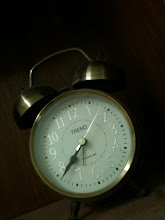I fell asleep relatively early yesterday, so I didn't have the opportunity to blog on that day. Now, the first part of OSCE is done, with 8 stations plus two rest stations. Tomorrow will be the second half of it, comprising of the remaining disciplines in the syllabus. As for today, the eight stations were as such:
Station 1 : Primary Care Medicine. A young male adult (
Damn, I forgot to ask his name. I only introduced myself to him) presented with history of back ache for 3 days. After detailed history and physical examination, you have made the diagnosis of muscle sprain. However he requested for an x-ray. How do you respond?
Station 2 : Rest Station
Station 3 : Ophthalmology. Picture of cataract given (
My friends answered with complete full mark i.e. posterior capsular cataract). We were asked about the findings and give the diagnosis. Then we were asked to list one local cause and 2 systemic causes. We were also asked to name two procedures that can be used to treat the condition and list 4 complications that may arise from the procedures.
Station 4 : Radiology. We were provided with two exhibits. The first one is a PA erect chest x-ray with haziness and consolidations all over the lung fields - diagnosis: miliary TB. Then what is the other test to confirm the diagnosis? - Sputum culture and sensitivity or smear to look for acid fast bacilli (choose one).
The second exhibit shows the x-ray of knee joints from two views, AP and lateral. A male patient in his 30's presented with history of sudden pain on the left thigh associated with swelling while he was playing badminton. Comment on the findings (AP view, no visible fracture but there is multiple cystic lesions on the distal part of the left femur. Lateral view, there is spiral fracture at the distal part of the femoral shaft of the left lower limb). What is the diagnosis? (
Pathological fracture secondary to aneurysmal bone cyst).Station 5 : Surgery. You as an HO in the ward saw Mr. Z unconscious following a surgery. Re-assess the Glasgow Coma Scale (GCS) level. It was written on the question
"Treat mannequin as a real patient".
After assessing, summarize the findings (supposed to be at the minimum, because a mannequin will surely not respond to any stimulus. Hence it will be 3 over 15.) . Then the examiner will give you another set of finding and asks you what is the GCS? Finally you will be ask what is the GCS level that you would intubate the patient? (
I answered less than 8. But please check because I'm not sure. Some of my friends said 8 and below.)
Station 6 : Primary Care Medicine - Drug Prescription. 2 year old (weight and height provided) presented with history of fever. Prescribe antipyrexia for this patient from what is listed. Tablet Paracetamol, Syrup Paracetamol, Tablet Aspirin, Soluble tablet aspirin. (
I'm sorry I can't recall the dosage.)
Station 7 : Rest station.
Station 8 : Ophthalmology. Do visual acuity test. Since the test was done in limited, confined space, mirror had to be used. (
I knew the "patient". She is a doctor. lol)
Station 9 : Psychiatry. Patient presented with history of low mood for three months, and had suicide intention for two weeks. Assess the suicidal risk in this patient. Use SAD PERSONS scale, and
"SAMPAH" mnemonics to assess whether the suicide was well planned or just to gain attention from others.
[S - Suicidal note. A - Avoidance (e.g. want to commit it in a locked room) M - Method (e.g. overdose, hanging, or slit wrist etc) P - Plan (when, where) A - Arrangement (I think it's redundant, but that's what the mnemonic is) H - Hint (e.g. by writing will, buy insurance).]
Station 10 : Orthopaedic Surgery. Patient had a fall and suffered anterior dislocation of the shoulder on the left arm. Ask for written consent for this patient for the close manipulation and reduction (CMR)
.
==========
So, for tomorrow there will be no more stations for Ophthalmology, Surgery, Primary Care Medicine, Radiology, Orthopaedic Surgery and Psychiatry. Let's revise for Obs-Gyn, Paediatrics, Emergency Medicine, Anaesthesiology, and Otorhinolaryngology (ENT). Medicine? I'm not sure, because some said that it won't come out because we have had our CPC under Department of Medicine (SLE with Anti-phospholipid syndrome). But, I think I still have to prepare just in case it may come out tomorrow. But for sure, I have to cover the rest first!
Let's do it...
p.s. Have to struggle for tomorrow because I think I'm not doing well enough. I must secure at least pass for this component. After this paper, there will be a gap before my long case paper on Tuesday and Short cases on Saturday (the last day!). Please, please, please, dear God please guide and help me to pass this exam and become a good and safe doctor. Ameen.








